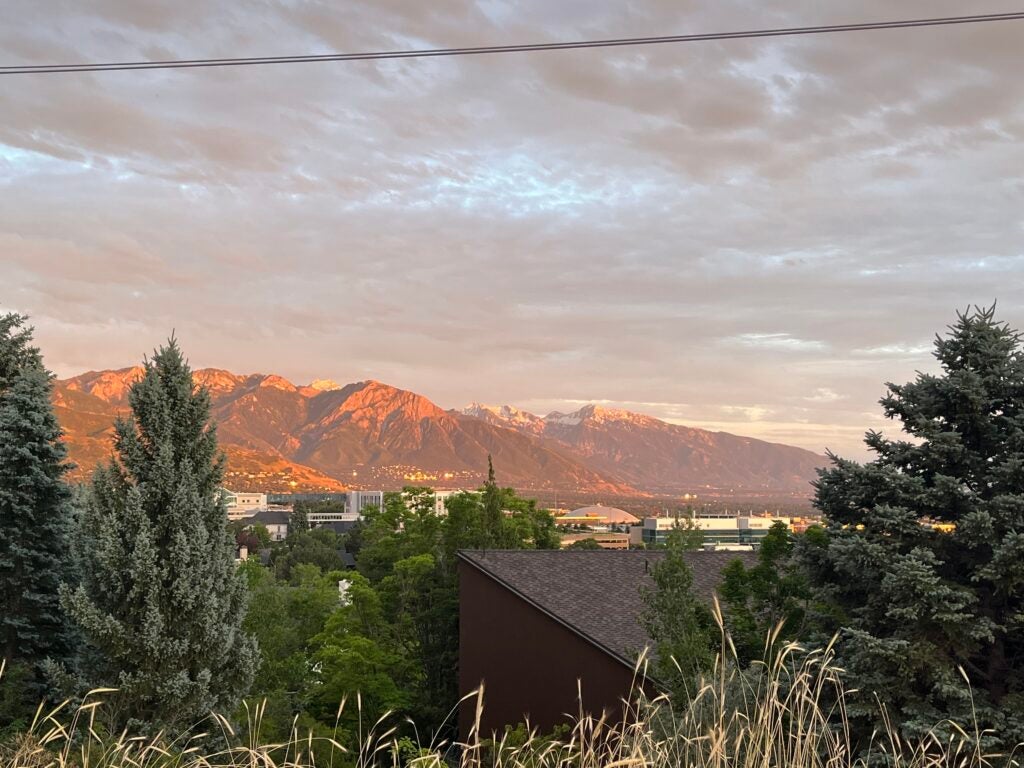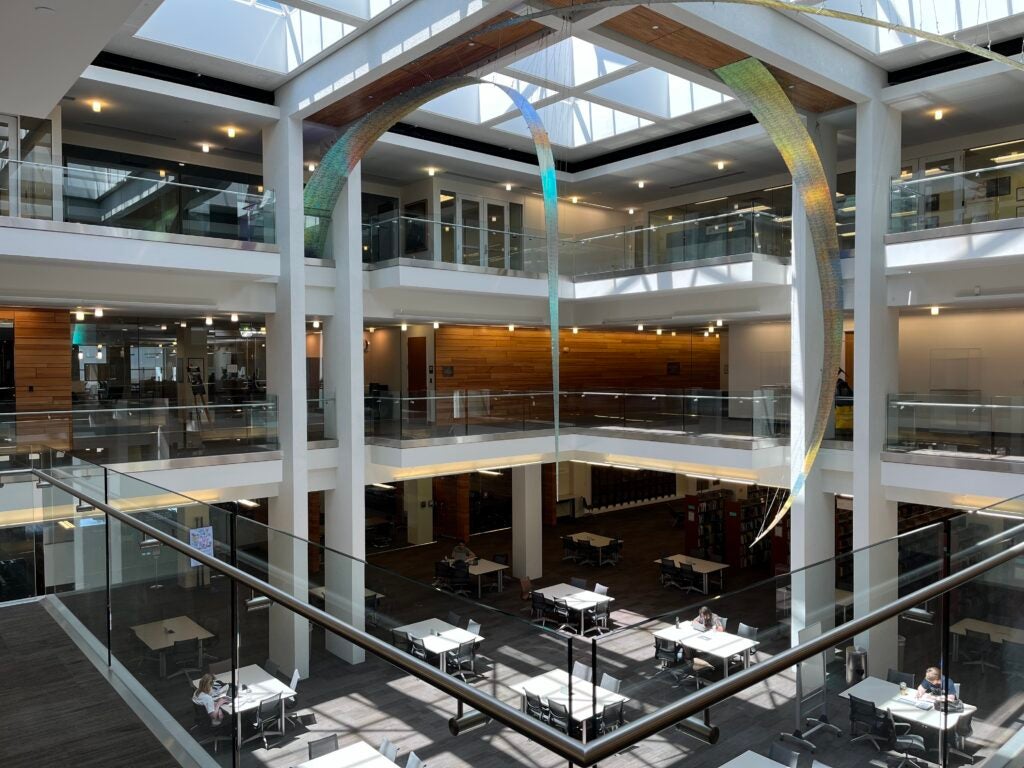
2024 Wrigley Institute Graduate Fellow Zak Breckenridge, a PhD student in the USC Dornsife Department of English, examines the work of environmentalist writers in the twentieth century. (Nick Neumann/USC Wrigley Institute)
The Lake, the Library, and the Literature of Environmental Crisis: Reading Wallace Stegner in the 21st Century
When I drove from Los Angeles to Salt Lake City this June, the desert was baking under a heat wave. When I arrived, Salt Lake City rose clean and monumental from the valley floor, cradled on both sides by mountain ranges: the Wasatch to the east and the Oquirrhs to the west. The French philosopher Jean Baudrillard once described this place as a “symmetrical, luminous, overpowering abstraction” that has “the transparency and supernatural, otherworldly cleanness of a thing from outer space.” As I drove into the city, the sky was a cloudless blue and the temperature was creeping toward 98 degrees.
I had come to Salt Lake for an archival research trip, made possible by the support of the Wrigley Institute. I am currently a doctoral candidate in English at USC, and my dissertation is about environmentalist writers in the twentieth century United States. In particular, I have been trying to track how some authors navigated ideas, aesthetics, and science as they came to understand the environmental devastation wrought by industrial development.
In part, I want to give a more subtle account of how environmentalist thought emerged in the mid-century. But also, as a student of literature with an interest in the history of science, I want to demonstrate the vital importance of the arts and humanities in a time of global ecological crisis. Climate change calls on us to find vivid ways to represent the natural world in its beauty, complexity, and fragility. Our response to the crisis must be cultural as well as technical.

My dissertation centers three writers: Aldo Leopold, Rachel Carson, and Wallace Stegner. All three are canonical eco-writers, but I think their undeniable influence has caused them to be read in reductive ways. Part of my research consists in studying notes, drafts, and obscure publications left behind in the archives. My hope is that I can get a more granular understanding of how literature, ecology, and advocacy braided together in the early years of the environmental movement.
I was in Salt Lake City because the University of Utah holds an extensive collection of Wallace Stegner’s papers. Stegner was a novelist, historian, and conservationist who lived from 1909 to 1993. Not widely read anymore, he is best remembered now for his self-reflexive historical novel Angle of Repose, which won the Pulitzer Prize in 1972.
Stegner was not just a writer. His influence traveled through words but also through the organizations and institutions in which he participated. He founded the creative writing program at Stanford University, served on the board of the Sierra Club, and advised the Secretary of the Interior on public lands policy, to give only a few examples. He was a key player in the 1952 fight against the construction of a dam in the heart of Dinosaur National Monument, a watershed moment in the history of environmentalism. Stegner not only blended art and advocacy, but was a literary writer with a keen interest in geology and ecology.
On this research trip, I learned the most about Stegner’s literary criticism. I knew about his novels and his conservation work, but he was also a careful and perceptive theorist of literature. For him, literature should be “a lens, not a gem”—a distillation of human experience that clarifies the dilemmas we face in real life. He saw literature not just as entertainment, but as a powerful way of knowing the world.
The Marriott Library, where the Stegner papers are held, is a sprawling concrete structure, partially embedded in a hillside that slopes up to the Wasatch foothills. Stegner’s papers are held here because he lived in Salt Lake as a young man and was an undergraduate at the University of Utah. He grew up hiking and camping across the state at a time when far fewer people visited the backcountry. He lived most of his adult life in the suburbs of San Francisco, where he taught at Stanford, but he maintained a lifelong connection to Utah.
Stegner loved the American West, and it appears often as both setting and subject in his fiction and nonfiction. One of his key ideas was that the West’s aridity imposed hard limits on economic development and resource exploitation. “Limitation, deprivation, are words we must keep in mind when speaking of the reputedly limitless West.” The water, which accumulates in the mountains and flows into the valleys and canyons, is limited, so development must likewise be limited. And the arid conditions of the Utah desert mean that scars on the land take much longer to heal than in the humid East. Stegner’s knowledge of history showed him how often these natural limits had been ignored, and the grave consequences for the plants, animals, and humans who inhabited the West.

This was not my first time in Salt Lake City. I lived there for three years, from 2017 to 2020, so I saw the city through the filter of both Stegner’s works and my own memories. The library, the campus, and the surrounding neighborhoods, all under the hush of summer, were both familiar and strange to me. Salt Lake is, for me, a place of striking beauty that epitomizes the challenges facing the West. The population of northern Utah is booming, and many new developments had sprouted in the four years I was away.
From the cemetery set on a hill north of the city, not far from where I stayed, the whole valley is laid out below you. The mountains rise, snow-capped and majestic, and this June, after a wet winter, the hills and valley floor were lush green. But you can also see the glimmer of the Great Salt Lake, where decreased inflow has been exposing the dry lakebed. Windblown dust worsens the already-bad air quality and settles in the mountains, making the snow melt faster and earlier. Also visible is the massive copper mine in Bingham Canyon, one of the largest human excavations on earth. An eyesore and a health hazard, the mine testifies to Utah’s history of profligate extraction.
I learned from a friend during my visit that there is now a plan to build a huge gravel mine in Parley’s Canyon, where I-80 enters the city. Not only will this pit mine greet every traveler coming from the east, but the canyon forms a wind tunnel that will blast particulate matter from the mine into the lungs of valley residents. In the meantime, temperatures are rising, here and across the West.
Throughout his life, Stegner regarded the West as a “geography of hope,” a place where better visions of the future could be invented and enacted. But he also recognized that the country’s arid regions were fragile and had suffered mistreatment and exploitation. He loved the West’s beauty, but he also learned that love is not always enough. As he once wrote, it is important “to understand what one loves, what is special or fragile about it, and how far love will take us. It is possible to love a country to death.”
Stegner dedicated his life not only to environmental protection, but to understanding the complexities of the past and the present in the fragile West. I hope that, by returning to his work with fresh eyes, we might learn something about what it means both to love places and to know them.
Zak Breckenridge is supported by the USC Dornsife Wrigley Institute Graduate Fellowship.